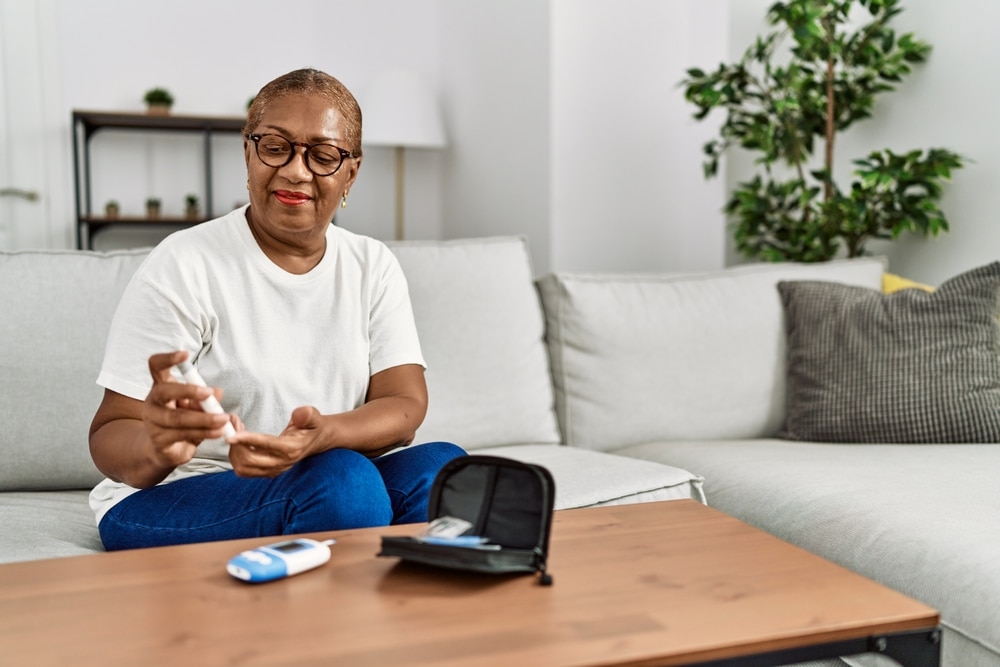Managing Diabetes
On this page:
- What are the diabetes ABCs?
- How can a healthy lifestyle help manage my diabetes?
- What types of medicines should I take?
- How can I check my blood glucose level at home?
- How can I keep track of my progress?
- What special situations should I plan for?
- Who should be on my health care team?
- Clinical Trials for Managing Diabetes
Diabetes can affect almost every part of your body, including your heart, eyes, kidneys, and nerves. Diabetes is also linked to some types of cancer. You may be able to prevent or delay diabetes health problems by leading a healthy lifestyle, taking your medicines, and managing your blood glucose level, also called blood sugar level. Work with your health care team to create a diabetes care plan that works for you.
What are the diabetes ABCs?
The diabetes ABCs can help you manage your blood glucose, blood pressure, and cholesterol levels. If you smoke, quitting is also important. Managing your ABCs may lower your chances of having health problems from diabetes, such as a heart attack, stroke, kidney disease, blindness, and foot or leg amputations.
A is for the A1C blood glucose test
The A1C test shows your average blood glucose level over the last 3 months. This test is done at a health care professional’s office or lab. For most people with diabetes, their goal is an A1C level below 7%.1 Your A1C goal may be different if you have other health problems.2 Ask your health care team how often you should have the test and what your goal should be.
B is for blood pressure
High blood pressure can damage your heart, kidneys, brain, and eyes. Some people with diabetes have a blood pressure goal below 130/80 mm Hg.2,3 If you have heart disease or are at high risk for diabetes health problems, your goal may be lower. Ask your health care team what your goal should be.
C is for cholesterol
Cholesterol is a fat, also called lipid, that is produced by your liver. Unhealthy levels of cholesterol in your blood can build up and clog your blood vessels, which may result in a heart attack or a stroke. Ask your health care team how often you need a cholesterol test, also called a lipid panel, and what your cholesterol level should be. Some people may need to take a medicine called a statin, or another medicine, to lower their cholesterol for heart health.
S is for stop smoking
Not smoking is important for your health, especially if you have diabetes. Both smoking and diabetes can make your blood vessels narrow. E-cigarettes aren’t a safe option either. If you smoke, vape, or use other tobacco products, stop. Ask for help so you don’t have to do it alone.
 Follow your ABCs to keep your heart healthy. A is for the A1C blood glucose test, B is for blood pressure, C is for cholesterol, and S is for stop smoking.
Follow your ABCs to keep your heart healthy. A is for the A1C blood glucose test, B is for blood pressure, C is for cholesterol, and S is for stop smoking.How can a healthy lifestyle help manage my diabetes?
Staying healthy when you have diabetes can be a challenge. But leading a healthy lifestyle may help keep your blood glucose, blood pressure, and cholesterol levels in the ranges recommended by your health care team.
Create a healthy meal plan
You may worry that having diabetes means going without foods you enjoy. The good news is that you can still eat your favorite foods, but you might need to eat smaller portions or enjoy them less often. Work with your health care team, which may include a registered dietitian or a diabetes educator, to create a meal plan that works for you.
Talk with your health care team about any challenges you may have finding healthy food. A doctor, registered dietician, diabetes educator, or social worker may be able to recommend resources that can help you. The U.S. Department of Agriculture also provides a list of resources about affording healthy food and finding help from food assistance programs.
Get physical activity
Physical activity may help you lower blood glucose, blood pressure, and cholesterol levels. Being active may also help you get better sleep and improve your mood. Try to get at least 150 minutes of moderate-intensity physical activity, such as brisk walking, each week. If you can, try to do muscle-strengthening activities, such as wall push-ups or seated arm raises, two days a week.4
Reach and maintain a healthy weight
If you are overweight or have obesity, ask your health care team how you can manage your weight. To lose weight, you may need to consume fewer calories or get more physical activity. Your health care team may also recommend medicines or surgery to help manage your weight.
Get enough sleep
Getting enough sleep may improve your mood, energy level, and blood glucose level. Most adults should aim for about 7 to 8 hours each night.5 Children and adolescents may need more sleep.
Take care of your mental health
Feeling stressed, sad, or angry can be common for people with diabetes. Many people with chronic, or long-term, illnesses such as diabetes develop anxiety or other mental health conditions. Learn healthy ways to lower your stress, and ask for help from your health care team or a mental health professional.
 Being physically active can help you manage your diabetes.
Being physically active can help you manage your diabetes.What types of medicines should I take?
Taking diabetes medicines is often part of managing diabetes. The medicines you take depend on your type of diabetes, how well medicines control your blood glucose level, and other health conditions you may have. You may also need medicines to help manage blood pressure or cholesterol levels. Other factors such as medicine costs, insurance coverage, who is providing your diabetes care, and your lifestyle can also affect what medicines you take.
Take your medicines as they were prescribed, even if you feel good or have reached your blood glucose, blood pressure, or cholesterol goals. Avoid rationing your medicines or skipping taking your medicines if you have trouble paying for them. Talk with your health care team if you can’t afford your medicines or if you experience any side effects.
How can I check my blood glucose level at home?
If you take insulin or other diabetes medicines, checking your blood glucose level at home may help you avoid high or low blood glucose levels. Even if you do not use insulin, checking your blood glucose level at home can help you manage your diabetes. The test results may help you and your health care team make changes to your meal plan, physical activity level, or diabetes medicines. It may help you understand how certain types of food affect your blood glucose level. You do not get the same level of detail from blood tests—such as the A1C test—that you take at a health care professional’s office.
If you have type 1 diabetes, your health care team may ask you to check your urine at home for substances called ketones. A large amount of ketones in your urine may mean that you need to manage your diabetes more carefully. Work with your primary health care professional—who may be a doctor, physician assistant, or nurse practitioner—to change your diabetes care plan. If high levels of ketones are left untreated, you may develop a dangerous condition called diabetic ketoacidosis.
 Checking and recording your blood glucose level is an important part of managing diabetes.
Checking and recording your blood glucose level is an important part of managing diabetes.Devices to help manage diabetes
You can check your blood glucose level at home with a blood glucose meter. The meter tests a drop of your blood, usually from a prick of your fingertip. The meter will show you how much glucose is in your blood at that moment.
People who take insulin to manage their diabetes may benefit from using a continuous glucose monitor (CGM). A CGM uses a sensor in the tissue under your skin and shows changes in glucose levels throughout the day and night. Many CGM systems have alarms and warnings that let you know if your glucose level is too low or too high.
For safety, you may sometimes need to compare your CGM glucose readings with results from a standard blood glucose meter. This could be needed if you doubt the accuracy of your CGM readings, if you are changing your insulin dose, or if your CGM gives a warning alert.
Some people use a CGM as part of an artificial pancreas. An artificial pancreas is a system that mimics how a healthy pancreas controls blood glucose in the body. A CGM, an insulin pump, and a software program that shares information between the CGM and insulin pump make up the artificial pancreas.
Ask your health care team about the best way to check your blood glucose level and how often you should check it. Make sure to keep a record of your blood glucose self-checks, including the date and time you checked it, the results, and other information, such as what you ate or what physical activity you did that day. You can use a chart or a smartphone app to help you keep track. Take this information with you when you visit your health care team.
Recommended targets for blood glucose levels
Talk with your health care team about the blood glucose range that is healthy for you. Be sure to tell your health care team if your glucose levels frequently go above or below your target range.
Many people with diabetes aim to keep their blood glucose at these levels1
- Before a meal: 80 to 130 mg/dL
- About 2 hours after a meal starts: less than 180 mg/dL
Your blood glucose goals may be different if you are an adult over age 65 and have had diabetes for a long time. Your blood glucose goals may also be different if you have other health problems, like heart disease, or if your blood glucose often gets too low.
If you use a CGM, your health care team may ask you to keep track of your time in range. Time in range is the percentage of time that your glucose level stays in your target range. For many people with diabetes, the target range is between 70 and 180 mg/dL. Your health care team may adjust your diabetes care plan to help you stay in your target range at least 70% of the time.
Low blood glucose
When your blood glucose level is too low, it is called hypoglycemia. For most people with diabetes, the blood glucose level is too low when it is below 70 mg/dL.1,2 Talk with your primary care professional or health care team if you often have low blood glucose levels. Some people with low blood glucose experience symptoms such as
- feeling shaky or jittery
- headache
- cold sweat
If you often have low blood glucose levels, you may need to change your diabetes meal plan, physical activity plan, or medicines. Very low blood glucose may lead to confusion or fainting, and it can become a serious medical emergency that must be treated right away.
Glucagon—a hormone that raises blood glucose levels—is the best way to treat severely low blood glucose. Ask your health care team if you need a prescription for glucagon. If you have a glucagon prescription, you should teach your family, friends, and coworkers when and how to give you glucagon in case you are not able to do it yourself.
High blood glucose
When your blood glucose level is too high, it is called hyperglycemia. For most people with diabetes, the blood glucose level is too high when it is above 180 mg/dL. Talk with your health care team if you often have high blood glucose levels. Some people with high blood glucose have symptoms such as
- feeling tired
- feeling thirsty
- having blurry vision
- urinating too often
If you often have high blood glucose levels, you may need to make a change to your diabetes meal plan, physical activity plan, or medicines. Very high blood glucose may lead to confusion or fainting, and it may become a serious medical emergency that must be treated right away.
Checking urine for ketones
Your health care team may want you to check your urine for ketones if you have symptoms of diabetic ketoacidosis. Diabetic ketoacidosis is a medical emergency that needs to be treated right away.
Symptoms of diabetic ketoacidosis include
- feeling very tired
- having trouble breathing
- having fruity-smelling breath
- fainting
Most often, ketoacidosis affects people with type 1 diabetes. However, some people with type 2 diabetes can develop ketoacidosis if they do not produce enough insulin.
How can I keep track of my progress?
You may find it helpful to keep track of your ABCs and other important health information that you get during checkups with your primary care professional or other health care professionals. Download the Health Checkups Tracker (DOCX, 67.97 KB) , which includes information you may want to track. You can take this information with you when you visit your health care team. Talk with your primary care professional about your goals and whether you need to make any changes to your diabetes care plan.
What special situations should I plan for?
If you have diabetes, it is important to take care of your health no matter what is going on in your life. Ask your health care team if you should adjust your meal plan, activity level, or medicines in special situations, such as when you are sick, fasting, at school, planning to travel, or experiencing an emergency or natural disaster.
Who should be on my health care team?
You are the most important member of your health care team, but working with your health care team may help you improve your self-care. Most people with diabetes get help from a primary care professional, such as an internal medicine doctor, family doctor, pediatrician, physician assistant, or certified nurse practitioner trained in diabetes care. Ask your primary care professional about adding other members to your team, including
- a diabetes educator, nurse, or registered dietitian who can tell you more about your disease and how to improve your self-care
- a dentist to check for gum diseases and other dental problems
- an eye doctor to check for diabetic eye disease
- a pharmacist to help you with your medicines
- other specialists if you develop health problems such as heart disease, kidney disease, erectile dysfunction, or foot problems
- a social worker who may be able to help you find financial help for diabetes care and community resources
Write a list of questions before your visit with a health care professional so you don’t forget what you want to ask.
 When you see your health care professional, discuss your diabetes self-care plan, review your blood glucose chart or app, and ask questions.
When you see your health care professional, discuss your diabetes self-care plan, review your blood glucose chart or app, and ask questions.Clinical Trials for Managing Diabetes
NIDDK conducts and supports clinical trials in many diseases and conditions, including diabetes. The trials look to find new ways to prevent, detect, or treat diseases and improve quality of life.
What are clinical trials for managing diabetes?
Clinical trials—and other types of clinical studies—are part of medical research and involve people like you. When you volunteer to take part in a clinical study, you help health care professionals and researchers learn more about diseases and improve health care for people in the future.
Researchers are studying many aspects of managing diabetes, such as
- what are the best medicines to add to a diabetes care plan if a person with type 2 diabetes isn’t meeting their blood glucose targets using their current diabetes medicines
- how to train adolescents to support or care for family members with diabetes
- how treating obesity with weight-loss medicines or weight-loss surgery, also called metabolic and bariatric surgery, may help manage type 2 diabetes
- what different devices can help people with diabetes check their blood glucose level and inject insulin
Find out if clinical trials are right for you.
Watch a video of NIDDK Director Dr. Griffin P. Rodgers explaining the importance of participating in clinical trials.
What clinical trials for managing diabetes are looking for participants?
You can view a filtered list of clinical studies on managing diabetes that are federally funded, open, and recruiting at ClinicalTrials.gov. You can expand or narrow the list to include clinical studies from industry, universities, and individuals; however, the National Institutes of Health does not review these studies and cannot ensure they are safe for you. Always talk with your primary health care professional before you participate in a clinical study.
What have we learned about managing diabetes from NIDDK-funded research?
The research funded by NIDDK has improved quality of life for people with diabetes by finding better ways to diagnose and treat the disease.
Artificial pancreas
For decades, NIDDK has supported research that helped create artificial pancreas technology used by some people who need insulin to manage their diabetes.
NIDDK supported research that helped scientists develop the first continuous glucose monitor (CGM) that was approved by the U.S. Food and Drug Administration (FDA) in 1999. CGMs, which are part of artificial pancreas systems, help people track glucose levels in real-time with fewer finger pricks. Another major milestone came in 2016, when the FDA approved a commercial “hybrid” artificial pancreas system. Other artificial pancreas systems have been approved since 2016. NIDDK continues to support research into artificial pancreas systems and other technologies that may improve diabetes management.
Blood glucose management studies
NIDDK funded the landmark Diabetes Control and Complications Trial (DCCT). The study showed that participants with type 1 diabetes who kept their blood glucose levels close to normal greatly lowered their chances of developing eye, kidney, and nerve disease. A follow-up study, the ongoing Epidemiology of Diabetes Interventions and Complications (EDIC) study, has continued to follow DCCT participants since 1994. EDIC has shown that there are long-term benefits of early and intensive blood glucose management on slowing or preventing the development of health problems such as heart, eye, kidney, and nerve diseases. Findings from the DCCT and EDIC studies changed the way diabetes is treated worldwide, and they show that blood glucose control can help people with diabetes lead longer and healthier lives.
NIDDK also funded the Diabetes & Aging Study to research the effects of early blood glucose management and the development of diabetes health problems in people with type 2 diabetes. The study found that people with less effective diabetes management during the first year after being diagnosed with diabetes had a higher risk of diabetes complications and death.
The Treatment Options for Type 2 Diabetes in Adolescents and Youth (TODAY) study and a follow-up study, TODAY2, found that type 2 diabetes can be more difficult to treat and manage when it occurs in younger people. The TODAY studies, both funded by NIDDK, show the importance of early, intensive treatment and blood glucose management for children or adolescents diagnosed with type 2 diabetes.
References
This content is provided as a service of the National Institute of Diabetes and Digestive and Kidney Diseases
(NIDDK), part of the National Institutes of Health. NIDDK translates and disseminates research findings to increase knowledge and understanding about health and disease among patients, health professionals, and the public. Content produced by NIDDK is carefully reviewed by NIDDK scientists and other experts.
NIDDK would like to thank:
Ariana R. Pichardo-Lowden, M.D., Penn State College of Medicine

